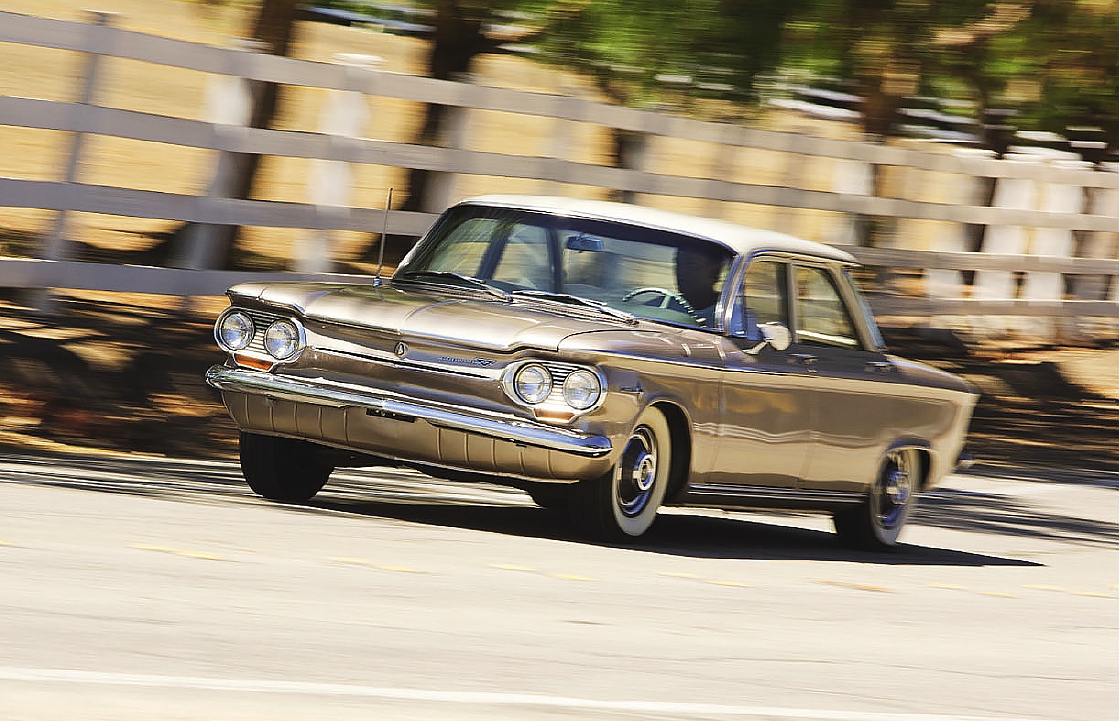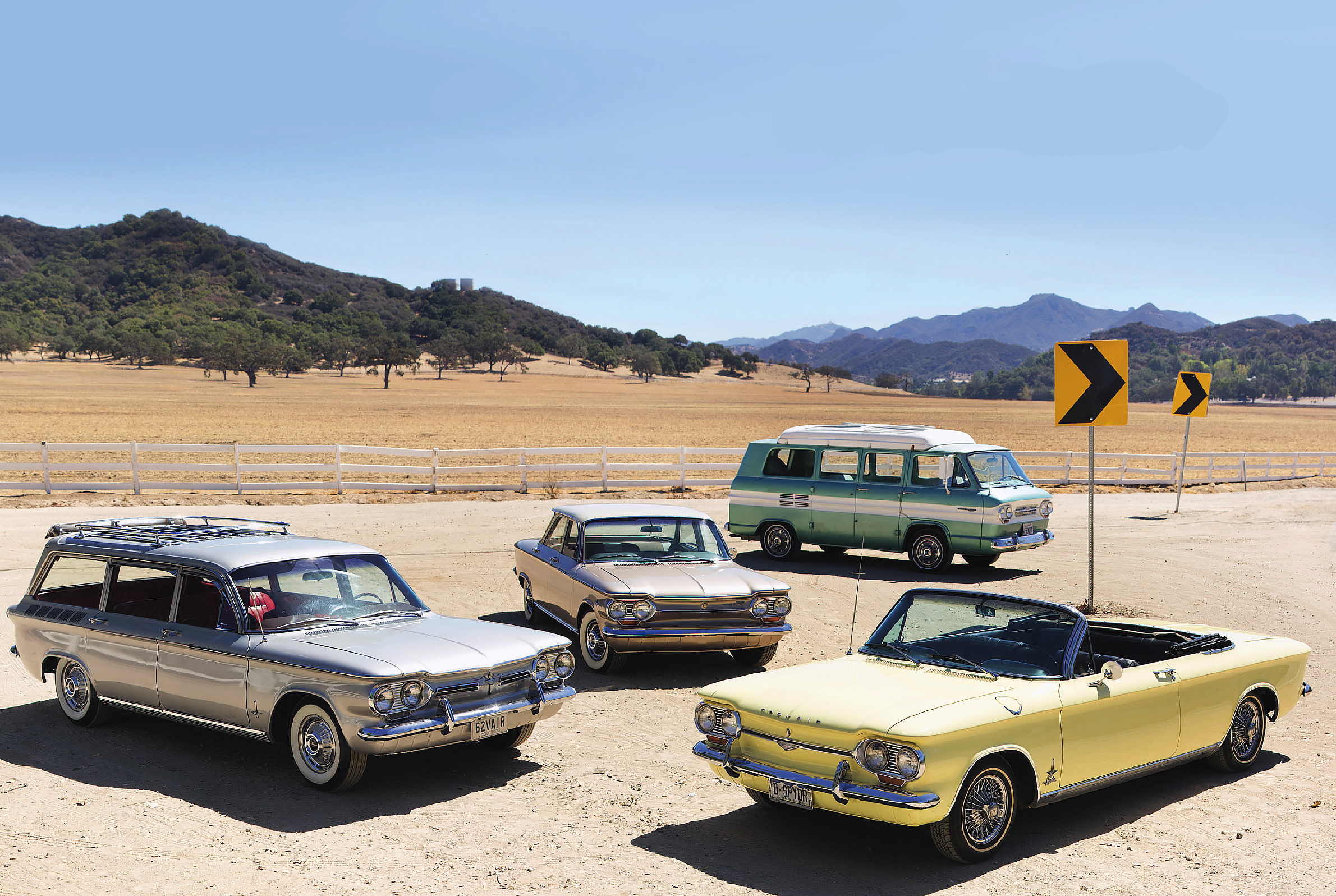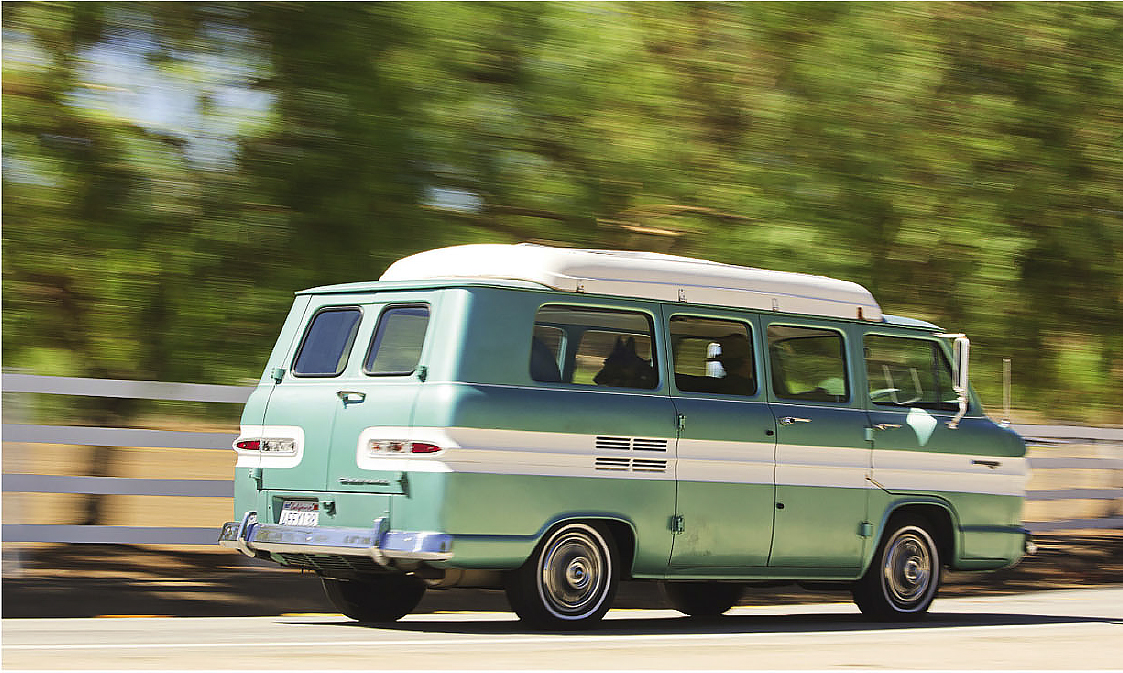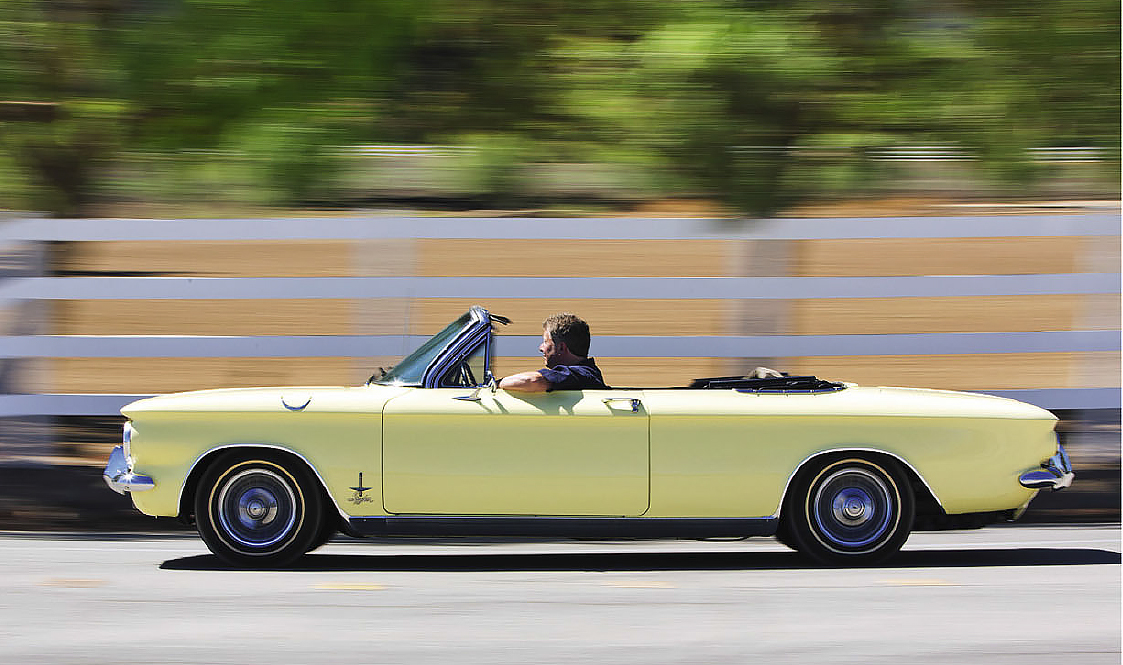
On the road to redemption. Ralph Nader’s verdict tainted the Chevrolet Corvair for life. But was it really that bad, asks Martin Buckley as he reassesses the much-maligned Chevrolet family? Photography Pawel Litwinski. Fifty years ago, American cars were built to a simple formula that was so proven and successful that few dared to deviate from it. The needs of marketing and styling outranked those of the engineers. It was deemed wiser to seduce the increasingly affluent public with ever greater size and more ostentatious visual distractions rather than take a technical risk that might not have a payback on the bottom line.

In an automotive culture that had become so narrow and inbred, the Chevrolet Corvair of 1959 was therefore a very laudable risk: an honest attempt to make a rational all-American small car that was much more than just a scaled- down and stripped-out big one. That General Motors had the vision and the bravery to build a design as radically different as this rear-engined oddity makes it all the more pitiable that we only seem to remember the Corvair when we want to conjure a metaphor for dangerous handling. These flawed but fascinating machines were much more than just the oversteering deathtraps highlighted so famously in Ralph Nader’s Unsafe at Any Speed.

With a whopping 60% of the weight at the back, traction was another advantage.
Nader and Corvair go together like Burke and Hare. Published in 1965, his 365-page enquiry into ‘the designed-in dangers of the American automobile’ devoted 42 pages of its first chapter to the failings of the Corvair and it is well worth reading because it is far from the rant you might expect. The campaigning – and non-driving – young attorney eloquently highlights the shortcomings of the car’s handling and details its involvement in some gory accidents, such as the lady from Santa Barbara who lost her arm when her Corvair flipped over at 35mph. Yet he also demonstrates that he understands the car’s appeal to enthusiasts and quotes experts such as John Fitch who, along with several others, made a living out of sorting the Chevy’s intrinsic ills.

There was a new appetite for a car like the Corvair in America as the ’60s dawned. Strong sales of small imports such as the Volkswagen Beetle and Renault Dauphine had alerted buyers to the possibilities of simple, economical and easy-to-park runabouts. Not everyone wanted one of the gargantuan domestic models. Those who did may still have needed a second car: the Corvair was born into a society that was, more than ever, building itself around the requirements of the motor vehicle and spreading out into a suburban sprawl away from shops and amenities. Almost everyone drove from the age of 16 onwards and it was fairly routine to have two or three cars in the family.
Time magazine now lists the Corvair as one of the 50 worst cars ever made, but applauded it on the front cover when it was new. The specialist magazines loved the car – Road & Track called it ‘A return to Sanity7 – but the Corvair made little impact in Europe. We had our own small cars, and preferred our Yanks full-sized. Corvairs are few and far between in the UK, so the chance to drive a full set of early models thanks to LA-based collector Mike Malamut was not to be missed.

Looks-wise, I find his original, low-mileage 700 Sedan the most satisfying. It was almost shockingly modern in 1959: low and clean on 13in wheels and as functionally elegant and unadorned as almost every other American car of the time was absurdly baroque. There is no fake front grille and little chrome but lots of glass, with a distinctive wraparound rear window and a beltline that marks the entire perimeter of the body. The influence of that styling device on cars as diverse as the Hillman Imp, the baby NSUs and the ’60s BMWs is under-recognised.

Top: first production turbo engine boasts its output; note fanbelt’s convoluted route around the flat-six. Above: clever nip-and-tuck makeover for ’65 model year brought the design bang up to date; elegant pillar less cabin featured on the Coupe and Sedan.
The simple, no-frills interior reminds you that the Corvair was basic transportation for Americans, a $2000 saloon about the size of an English Ford Zephyr but with a six-seater, flat-floored cabin – Chevrolet’s first true unitary shell – that’s almost as roomy as a regular American sedan.
The gear selector is just a three-position switch adjacent to a simple ribbon speedo and, apart from oil temperature and charging lights – to let you know if the tortuously routed fanbelt has come off – there are few other distractions.
With a decent amount of luggage space in the nose and behind the front seats (plus the 9 1/2-gallon fuel tank just the other side of the bulkhead), the rear engine location, still fashion-able in Europe, was at least justified for packaging benefits. With a whopping 60% of its weight over the back wheels, another practical advantage was traction. Chevrolet made a promotional film of the Corvair effortlessly traversing rivers and muddy tracks to ram the point home.
From below: long load bay in rare Lakewood, but floor is high because it sits over the engine; floor change so Buckley says it’s much easier to reach the limits of the sometimes wayward handling with 95bhp flat- six; vents on rear flanks signal engine’s location
At just under 2.3 litres, its 80bhp oversquare air-cooled boxer motor – the world’s only flat-six passenger-car engine at the time – should make the Sedan cruise at close to its 88mph maximum and give 30mpg if driven gently, as long as you don’t use the (optional) petrol heater too much.
Once under way, the 700 doesn’t have much in the way of acceleration – 60mph came up in a glacial 17.5 secs in the two-speed auto, according to tests – and runs out of steam on most hills. But, thanks to hydraulic tappets, it is smooth and quiet, with little noise from the engine fan, which is mounted horizontally above the crankcase to cool the finned cast-iron cylinder barrels. Compared to a Volkswagen Beetle, it positively whispers.
Its light, sloppy, low-geared steering and dead-feeling drum brakes are common to all of these early Corvairs and, when you corner with anything approaching enthusiasm, you feel the loaded swing-axle dig in as the back end rolls and the front end stays relatively flat. For me, there is not enough power to get you into the difficulties Mr Nader talks about – but it does feel under-tyred and winding on corrective lock would be a slow and imprecise process with nearly five turns lock-to-lock in the floppy mechanism.
For want of a front anti-roll bar, Chevrolet’s engineers simply took the cheaper route and specified a huge discrepancy in the front and rear tyre pressures -15 and 26psi respectively – in an effort to dial-in understeer, although this seems to have been at the heart of the handling problems that got high-profile victims such as TV comedian Ernie Kovacs into trouble.
At the very least, it was critical to keep an eye on the tyre pressures, but, as Nader pointed out, was it really sensible or safe to expect owners to keep to this regime, which was really making up for faults in the basic design of one of the world’s most tail-heavy vehicles? Even if they did, there was too much conflicting information about what the ideal pressures should be.
Kovacs died in one of the rare Lakewood
Who would want the cliché of a VW camper when you could have something this cool?
Station Wagons that were only offered for two seasons. This usefully spacious silver estate – boasting 95bhp and four speeds in a pleasingly accurate manual centre-change gearbox – with its dazzling red plastic interior and handsome roof bars, is significantly livelier but also noisier than the Sedan because the flat-six sits just beneath the raised luggage deck.
Versatile Greenbrier could be kitted out with a raft of accessories to turn it into a camper, including a popup roof tent and top tent; two-tone theme continues inside – room for six in the back. And it was surely the inspiration for Scooby Doo’s Mystery Machine
On its supple Quadraflex swing-axles, the Lakewood has the same comfy big-car ride as the Sedan. It feels fairly tidy on long, medium- speed curves but you can flick its tail out on slow corners taken bullishly. It is a lurchy and untidy rather than precise art – and probably looks alarming from the outside – but it is also fun, rather than scary. You can appreciate how the Corvair became such a favourite with enthusiast buyers who took some interest in their driving. On the other hand, you can also see how it might have caught out the 100 or so less-keen drivers who took out lawsuits against GM after having ‘one car’ accidents in their tail-happy Corvairs. American barges had been designed to understeer for decades. The opposite condition was something quite new to most people.
After 1960, Chevrolet took the car in another direction from its poverty-model roots. It soon created a conventional entry-level model called the Chevy II (to take on the Plymouth Valiant and Ford Falcon compacts) and promoted the
From below: clever hood looks good when up and folds neatly out of sight into space behind rear seat; stylish script badge; engine-lid emblem reads ‘Turbo Charged’; plenty of dials in the well-equipped dashboard – even cylinder- head temperature gauge
Corvair as a speciality sporty car that, in some respects, did the marketing groundwork for the Mustang’s success. By mid-1960, there was a bucket-seated Monza variant of the Club Coupe with a high-lift camshaft and a less restricted exhaust system. Soon this 95bhp engine option was taking half of all Corvair sales.
At the more functional end of the market, the Corvan and Loadside/Rampside pick-ups developed the range in a commercial direction.
You could argue that Malamut’s cute Greenbrier Sports Wagon minibus was an early attempt at an space vehicle. With light forward-control steering and an unobtrusive two-speed Power-Glide transmission, it is a smooth six-seater for fun- loving all-American families. It has a higher centre of gravity, though, so I’m willing to believe the rumours that it is potentially the most evil-handling of all the Corvair variants. Having said that, this scarce Greenbrier is undeniably the near-double of the Scooby Doo ‘Mystery Machine’, which probably forgives it most things. And who would want the awful cliche of a Volkswagen camper when you could have something really cool like this?
The convertible arrived at the start of ’62 and provided the basis for the undoubted star of the Corvair line-up. It was followed in March by the Monza Spyder, the first passenger car with an exhaust-gas-driven supercharger – or what is better known today as a turbocharger. With larger intake valves, plus beefed-up conrods and bearings and radical ignition timing, this engine gave nearly 50% more power than the 102bhp twin-carb Monza. Its 150bhp at maximum 11psi boost was good for 0-60mph in 10 secs and a 110mph top end. The Spyder came as standard with four speeds, and a 3.55:1 limited-slip diff.
This 1964 example, sporting optional Kelsey Hayes bolt-on wires, pulls cleanly and powerfully to 5000rpm. You can watch the boost build on a gauge that forms part of the five-instrument set – or even check your cylinder-head temperatures. The shapeless, non-reclining seats are uninspiring, the lapbelts useless and nothing seems to fit that well – another reminder that this was a cheap-and-cheerful model. With sintered linings, the drum brakes should work better but the steering is still vague, and so light that it could almost be power-assisted.
With the neatly configured power hood lowered – it sits well down for a clean side profile – you can hear the hard ring of the flat-six all the better, which encourages you to make good use of the meaty-feeling gearshift, its long, curving shaft topped by a knob like a white pool ball. The heavy but progressive clutch has uprated springs and lining to take the turbocharged urge.
If it is not quite the sports car the cheerleaders for the Corvair might like to imagine, then the Monza Spyder – confusingly also available as a Coupe – is a genuinely impressive car for which no excuses should be made. It corners quite flat on its ‘heavy duty’ springs – encouraging you to give it all you dare in its 7 0mph third – and romps through dry sweepers, feeling as safe and stable as the lesser variants are uncertain and skittish. Dan Gurney ran one in Europe when he drove for the Porsche works team. That has to be some kind of recommendation, even allowing for the possibility that his Spyder was a fringe benefit.
It romps through sweepers, feeling as stable as the lesser models are skittish.
The Corvair was not a straightforward failure. Through to the mid-’60s – before Nader’s attentions began to scare buyers off – the model sold to the tune of 200,000 a year in its various forms. And total sales of nearly 1.8 million over 10 years can hardly be counted as a disaster.
Writing about the Chevrolet Corvair has a flavour of that Not the Nine O’clock News sketch, ‘The Devil, is he all bad?’ How can you make a case for an automobile that is a kind of shorthand not just for ‘bad car’ but also exemplifies ‘industrial irresponsibility’ (as Ralph Nader put it) in a wider context? Probably you can’t. Yet these cars have a singular character, an intrigue and an optimism about them that transcends if not quite outweighs the considerable negatives.
As for Nader, he has a lot to thank the Corvair for because the car helped to make his name – even if it didn’t quite propel him into the White House when he most recently ran for President in 2008. He once agreed to be guest speaker at a Corvair Society of America AGM, which at least shows he has a sense of humour.
Corvair, take two
The second-generation Corvairs were among the best-looking American cars of the ’60s. The bigger, 2.6-litre flat-six came in 95,110 and 140bhp Corsa forms. The latter was good for 180bhp if you ticked the Turbo option box. Virtually everything had been tweaked and improved to make the 1965 model the car the Corvair should have been from the beginning.
{gallery}ChevroletCorvair{/gallery}
The best news, though, was that the handling had been properly sorted by fitting Corvette- type trailing-arm rear suspension but with coil springs rather than the sports car’s transverse leaf. The result was far less camber change and a much lower rear roll-centre. This, combined with quicker steering (or the option of an even faster-ratio box) made for a Corvair that could track through a 65mph corner that would have alarmed a driver of the previous model at anything over 35mph, and could be held in four- wheel drifts by the moderately talented.

Chevrolet Corvair Yenko Stinger Stage I 1966
Even so, the new styling and sorted rear suspension of the later models failed to recover the public’s confidence in the Corvair and GM seemed content to let the car quietly die with a vastly reduced model range and almost no advertising. The initially enthusiastic reaction to the trimmed-down line-up – convertible, hard-top sedan and coupe – was a healthy first-season output of 235,528 cars, although this had dropped to 27,253 by 1967.
Nader’s campaign against the Corvair was probably only partially to blame, because it was doomed once the Mustang appeared.





